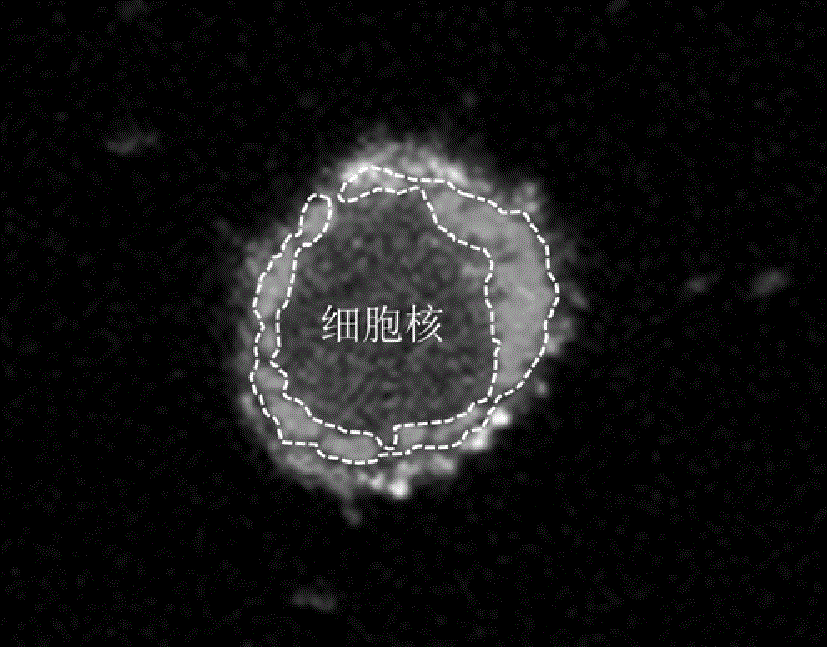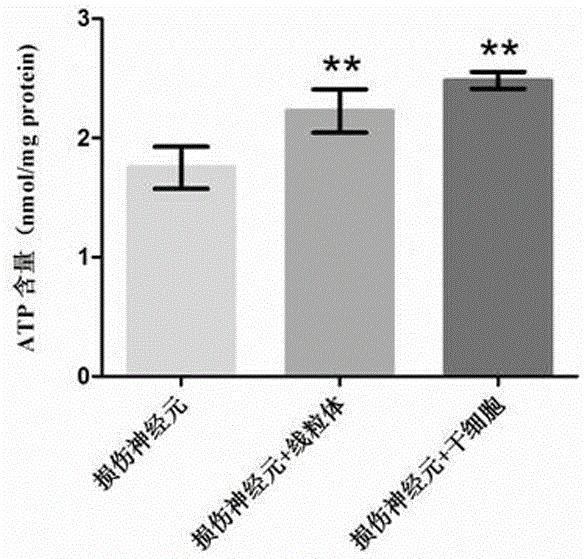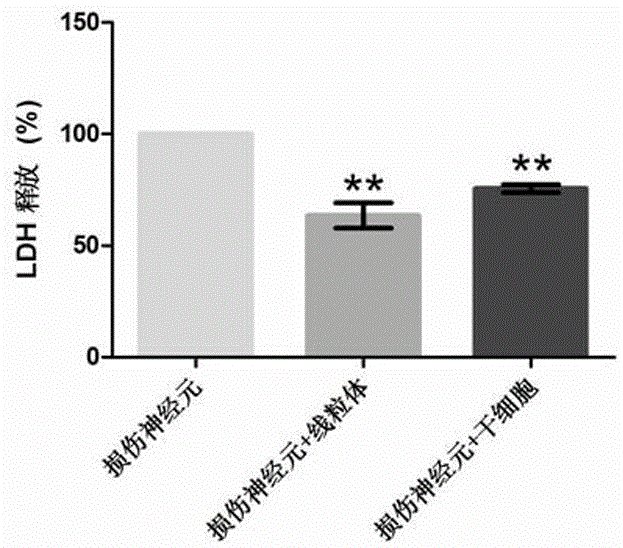Method for promoting survival of injured neurons by virtue of mitochondria transplantation
A neuron survival and mitochondrial technology, applied in the field of stem cell-based biotechnology, can solve problems such as immunogenicity, and achieve the effect of avoiding implantation, avoiding immunogenicity problems, and promoting neuronal cell regeneration
- Summary
- Abstract
- Description
- Claims
- Application Information
AI Technical Summary
Problems solved by technology
Method used
Image
Examples
Embodiment 1
[0026] Example 1: Mitochondria (BMSC-MitC) derived from bone marrow mesenchymal stem cells (BMSCs) increase ATP in damaged motor neurons.
[0027] VSC4.1 motor neurons 5 × 10 4 Each cell was planted in a 24-well plate, and oxygen-glucose deprivation (OGD 8h) induced neuronal injury model. There were three groups: OGD model group; OGD+BMSCs group (5×10 4 BMSCs / well, co-cultured in transwell for 24 h); OGD+BMSC-MitC group (mitochondrion was added to the medium, from 1.7×10 6 BMSCs / well, incubated for 4 h). After the time point, the ATP content in the neuron cells was measured using Beyontek's ATP kit. After 8 hours of OGD treatment, the ATP content of neurons decreased to 1 / 3 of the normal group, which was 1.75±0.08 nmol / mg protein; after 4 hours of mitochondrial co-culture, the ATP content increased significantly to 2.20±0.09 nmol / mg protein; BMSCs co-cultured for 24 hours, the ATP content increased significantly to 2.48±0.03 nmol / mg protein. There was no significant diff...
Embodiment 2
[0028] Example 2: Mitochondria derived from bone marrow mesenchymal stem cells (BMSC-MitC) promote the survival of injured motor neurons.
[0029] VSC4.1 motor neurons 5×10 4 Each cell was planted in a 24-well plate, and oxygen-glucose deprivation (OGD 8h) induced neuronal injury model. There were three groups: OGD model group; OGD+BMSCs group (5×10 4 BMSCs / well, co-cultured in transwell for 24h); OGD+BMSC-MitC group (mitochondrion was added to the medium, from 1.7×10 6 BMSCs / well, incubated for 4 h). After the time point, the LDH content in the cell supernatant was determined by using the LDH detection kit. After 8 hours of OGD treatment, the LDH content in the motor neuron supernatant increased significantly; after 4 hours of mitochondrial co-culture, the LDH content was significantly reduced to 63.40±5.61% of the OGD group; BMSCs co-cultured for 24 hours, the LDH content was significantly reduced to 75.52±1.83% of the OGD group. There was no significant difference in ...
Embodiment 3
[0030] Example 3: BMSC-MitC transplantation promotes structural regeneration and functional recovery after spinal cord injury in rats.
[0031] Establishment of spinal cord impact injury model in rats: 8-week-old female SD rats were anesthetized by intraperitoneal injection of 10% chloral hydrate at 4 ml / kg after fasting for 7-12 hours before the experiment. After 1-2 min, the rat's muscles relax, the pain reflex disappears, and the anesthesia is successful. Rats were placed on an electric blanket in a prone position, the hair on the back was shaved, disinfected with iodine from the inside out, and a towel was spread. Separate and expose the T10 segment of the spinal cord. The spinal cord was impacted at a height of 5 cm using a spinal cord injury impactor (NYU ImpactorII). After the blow, the rat's spinal cord was congested, the hind limbs twitched, the tail flicked, and then completely relaxed. Divided into three groups: SCI+solvent group (H-DMEM); SCI+mitochondria group ...
PUM
 Login to View More
Login to View More Abstract
Description
Claims
Application Information
 Login to View More
Login to View More - R&D
- Intellectual Property
- Life Sciences
- Materials
- Tech Scout
- Unparalleled Data Quality
- Higher Quality Content
- 60% Fewer Hallucinations
Browse by: Latest US Patents, China's latest patents, Technical Efficacy Thesaurus, Application Domain, Technology Topic, Popular Technical Reports.
© 2025 PatSnap. All rights reserved.Legal|Privacy policy|Modern Slavery Act Transparency Statement|Sitemap|About US| Contact US: help@patsnap.com



